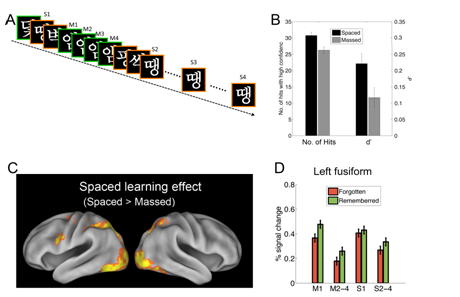Brain-based Learning Facilitation
One important part of ongoing research at CBLS is to develop novel brain-based approaches to facilitate learning. Currently, we are actively exploring the following strategies:
The first strategy is to develop and verify behavioral approaches that can enhance the neural signatures of effective learning. For example, we have found spaced learning, as compared to massed learning, could reduce the neural repetition priming in the left fusiform area, and improve the memory performance for novel faces (Xue et al., 2011, JOCN) and novel scripts (Xue et al,2010, Plos One).
The second strategy is to explore the effect of noninvasive brain stimulation technology, such as Transcranial direct current stimulation (tDCS) in improving learning. For example, we found that anodal tDCS over the LIFG could enhance maladaptive learning (e.g., Xue et al., PNAS, 2012). We are current examining whether tDCS could improve both short-term and long-term memory.
The third strategy is to use EEG based brain-computer interface (BCI). Specifically, we are interested in testing the feasibility, effectiveness and limitations of BCI technology in enhancing human learning.
Finally, we are examining the effect of brain training and cognitive enhancement in improving learning. Due to the critical role of attention, working memory and executive function in effective learning, we are extremely interested in how brain training that aims to improve these fundamental cognitive functions can improve brain function and learning efficiency.
The brain-based technologies that is currently used in CBLS to facilitate learning efficiency.
